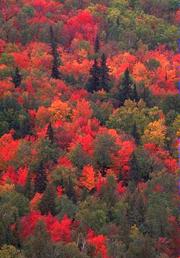|
Deciduous
Forest: Plants
Trees of this
biome include both broadleaf, deciduous trees, such as maple, oak,
hickory, and beech, and evergreens, such as hemlock, spruce, and
fir. A deciduous forest typically has three to four, and sometimes
five, layers of plant growth.
Tall deciduous trees
make up the top layer of plant growth, and they create a moderately
dense forest canopy. Although the canopy is moderately dense, it
does allow sunlight to reach the forest floor. This sunlight allows
plants in the other layers to grow. The second layer of plant growth
includes saplings and species of trees that are naturally shorter
in stature. A third layer (or understory) would include shrubs.
Forest herbs, such as wildflowers and berries, make up a fourth
layer. During the spring, before the deciduous trees leaf out, these
herbs bloom and grow quickly in order to take advantage of the sunlight.
A fifth layer would include mosses and lichens that grow on tree
trunks.
 Plant
adaptations Plant
adaptations
In the spring, deciduous trees begin producing thin, broad, light-weight
leaves. This type of leaf structure easily captures the sunlight
needed for food production (photosynthesis). The broad leaves are
great when temperatures are warm and there is plenty of sunlight.
However, when temperatures are cold, the broad leaves expose too
much surface area to water loss and tissue damage. To help prevent
this damage from occurring, deciduous trees make internal and physical
adaptations that are triggered by changes in the climate.
Cooler temperatures and
limited sunlight are two climatic conditions that tell the tree
to begin adapting. In the Fall, when these conditions occur, the
tree cuts off the supply of water to the leaves and seals off the
area between the leaf stem and the tree trunk. With limited sunlight
and water, the leaf is unable to continue producing chlorophyll,
the "green" stuff in the leaves, and as the chlorophyll decreases
the leaves change color. The beautiful display of brilliant red,
yellow, and gold leaves, associated with deciduous forests in the
fall, is a result of this process. Most deciduous trees shed their
leaves, once the leaves are brown and dry. Photos
© 2000-www.arttoday.com
Back
| Next
|











